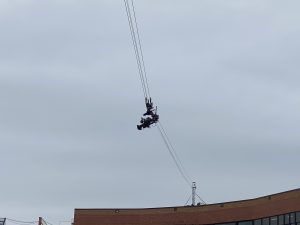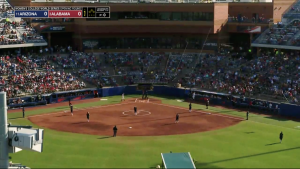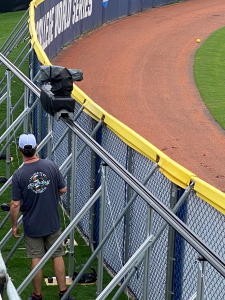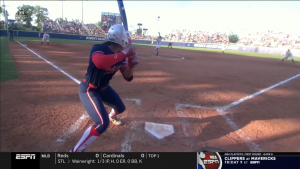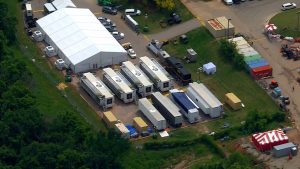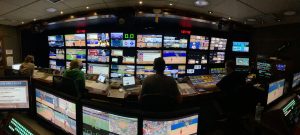Women’s College World Series: ESPN Celebrates 20th Year in OKC With 80-Ft. Rail Cam, Cable Cam, Drone
Although most of the crew is onsite, on-air packages are being produced offsite
Story Highlights
After being canceled by the pandemic last year, the NCAA Women’s College World Series is certainly making up for lost time, logging multiple upsets by the unseeded James Madison Dukes and the fifth perfect game in history by Alabama’s Montana Fouts. Celebrating two decades covering the full tournament in Oklahoma City, ESPN has deployed some flashy tech in its return to the diamond, with an 80-ft. Rail Cam along the left-field and centerfield walls, a two-point cable camera system running down the third-base side, an aerial drone for breathtaking images, Ump Cam, and much more.
“From the time UCLA won the [2019] national championship and the time we threw the first pitch during the first game, there have been 730 days,” says Meg Aronowitz, senior coordinating producer, ESPN. “We were really excited to gather together in that catering tent at 8:30 on that first morning.”
Up in the Air: Cable Cam, Drone Give Large-Scale Looks at the Action
Two of the more noticeable tech implementations used throughout the eight-day tournament are above the heads of the spectators. High in the air, a drone has been capturing the surrounding areas as well as the packed crowds that are a welcome sight after a year without fans in stands. Closer to the ground, a two-point cable camera system is covering the area from the backstop down the left-field line.
The reason to deploy these two devices is two-fold. On the production end, each camera offers a different view of the action on the field. For example, the cable cam can show a ball hit into the outfield and a runner rounding third and heading home to score in one attempt. Also, during stoppages in play, it’s able to show the crowd and head up the protective netting to show the broadcast team in the booth behind home plate. On the other hand, the two cameras showcase the last step of a four-phase renovation of OGE Energy Field, including upper-deck seating that pushes the venue’s capacity to 13,000.
“Our directors and I spent a lot of time thinking through what would add value [to the broadcast],” says Aronowitz. “We’ve always wanted to do some form of cable-camera system, but, before the upper deck was put in, the stadium was wide open, and the wind in Oklahoma is not your friend. Now the upper deck has helped us fight off that wind.”
In the bigger picture, the pandemic ripped the excitement of OKC away from fans last year, but, on the technological side, it forced ESPN to postpone the debut of this new cable system. The multimillion-dollar renovation reached its completion in time for the 2020 tournament, but the one-year-old upper deck has been retrofitted with the Supracam system. The drone, though, was something of a last-minute decision when the NCAA allowed more attendees.
“We didn’t know what the crowd was going to look like,” Aronowitz notes, “but we wanted to bring the drone and show off the size and the scale of the stadium. The lensing on the drone doesn’t allow you to necessarily follow the ball, but we’ll have a fixed-wing airplane for that during the finals.”
At Ground Level: Rail Cam, Ump Cam, Ross PIERO Highlight Each Play
Along with the two-point cable system and an aerial drone, there are other tech highlights that make up the 42 cameras in OKC. Rail Cam has attracted the attention of viewers watching the action from their homes. Constructed on an 80-ft. track that spans from left field to centerfield, a mounted Fletcher robo camera provides engaging replays of diving catches, balls hit into the gap, and other plays in the outfield. After internal discussions and collaboration with USA Softball to get the right amount of physical space, the network was able to find the perfect iteration of this technological innovation.
“Doug Holmes, who directs the Little League World Series, had a robotic camera on a smaller Rail Cam system in the outfield at one point,” notes Aronowitz. “[Women’s College World Series Director] Anthony DeMarco and I started talking about the vision for what the camera can do. If it’s moving and we’re able to move/tilt/zoom as the ball is coming into frame, it could be a really cool perspective.”
Even before the Championship Series, the Rail Cam had become a resounding success. The current system features only one rail, one camera, and one portion of the wall, but Aronowitz and her team are already thinking of ways to incorporate multiple systems to cover the entire length of the warning track.
Returning to Oklahoma City is Ump Cam, a small POV camera attached to the helmet of each game’s home-plate umpire. Also seen during the 2019 College World Series, the production crew has found the perfect iteration of this activation, which combines 3G Wireless’s newest HD camera and a sturdy camera feed.
“We’ve had Ump Cam for a couple of years,” Aronowitz explains, “but the RF frequencies and the distance have always been a challenge for us. 3G has upgraded their system, and we’ve been able to give them line of sight between the umpire and the system, so we’ve had a lot of great replay angles of strikeouts.”
Lastly, the network has been relying heavily on telestration for breaking down crucial plays and web gems throughout the telecast. Used during live coverage and instant replays, Ross Video’s PIERO sports-graphics package allows interactive opportunities for the broadcast teams of Beth Mowins, Jessica Mendoza, and Michele Smith as well as Kevin Brown and Amanda Scarborough.
Out in the Compound: NEP’s EN1 Handles Game Coverage, Onsite Studio Show
The unpredictable nature of the pandemic has caused networks to alter onsite plans at a moment’s notice. Luckily, thanks to a higher rate of vaccination and positive turn in cases, ESPN was able to credential more individuals than had been expected. The number of staffers in Oklahoma City peaked at 200 but, with two or three games remaining, has decreased to 160.
Following the trend of the past year, remote staffers are editing and putting together on-air packages from offsite locations via a delivery pipe supplied by Creative Mobile Solutions. Since this tournament is being produced with a mostly onsite team, the broadcasts are being elevated since all involved can experience the tension, emotion, and excitement of each game.
“There’s something about being here that you can’t replicate,” Aronowitz says. “You don’t get as excited when you’re 3,000 miles away, but I’m really proud of what our remote edit team is doing and the content that they’re creating.”
Over in the television compound, ESPN’s flagship mobile unit for Monday Night Football, NEP EN1, is hosting most of the production team. With COVID-19 guidelines still in effect, teams are being separated in the truck’s A, B, C, D, and E units and other flex units, trailers, and portable offices. EN1 is doing double duty in OKC, handling both the live game and the studio show, with the studio located behind the right-field wall. 7Innings Live, featuring Courtney Lyle, Kayla Braud, and Jenny-Dalton Hill, deploys a core of four cameras: two stationary, one jib, and one beauty. In addition, the interconnectivity of EN1 allows the studio show to tap into cameras positioned throughout the stadium and normally dedicated to the game.
At the institutional level, a handful of ESPN’s conference-centric programs spent a lot of time in Oklahoma City. With Alabama making it to the semifinal, SEC Network’s SEC Now with Alyssa Lang and Madison Shipman presented analysis and other content about the Crimson Tide’s deep postseason run. The ACC Network covered, and is still covering, Florida State’s dash to the title series with an onsite edition of All ACC with Kelsey Riggs, Jordan Cornette, and Dalen Cuff and live onsite reporting by Katie George.
Family Reunion: ESPN Crew Come Together at College Softball’s Grandest Stage
For all who work in Division I softball, all roads lead to Oklahoma City, and the crew at ESPN is happy to finally be back in the Sooner State. It has been a slow burn for Aronowitz as she witnessed the gradual return to normalcy at each collegiate championship. As the calendar slowly crept toward May, the dedication of her team never wavered but only became stronger.
“I remember being at wrestling [in March] and the Frozen Four [in April], and, after each one, there was a little more access,” she says. “The thing that hasn’t changed is the passion of my crew because they’re extremely happy to be back doing what they love. Our first game back was a really good day.”
Florida State University and the University of Oklahoma will face off in tonight’s Game 1 of the Women’s College World Series at 7:30 p.m. ET on ESPN.
